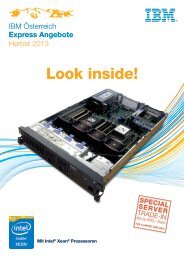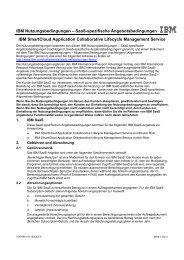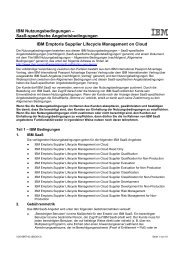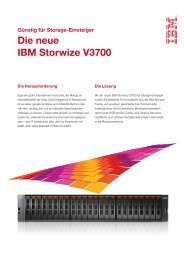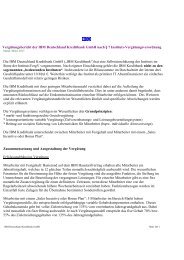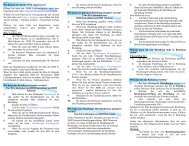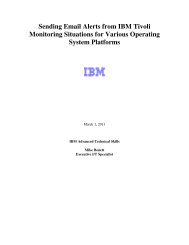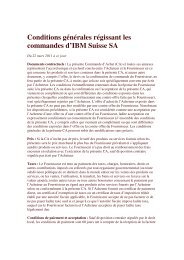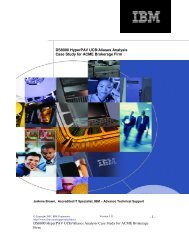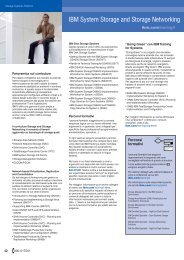FICON Express2 Channel Performance Version 1.0 - IBM
FICON Express2 Channel Performance Version 1.0 - IBM
FICON Express2 Channel Performance Version 1.0 - IBM
Create successful ePaper yourself
Turn your PDF publications into a flip-book with our unique Google optimized e-Paper software.
<strong>FICON</strong> <strong>Express2</strong> <strong>Channel</strong> <strong>Performance</strong> <strong>Version</strong> <strong>1.0</strong><br />
Page 30<br />
The first column “PORT ADDR” identifies the switch port address. The 2nd and 3rd<br />
“CONNECTION” columns identify what this switch port is connected to. The “UNIT”<br />
indicates whether is it a channel (CHP-H), a control unit port (CU) or in the case where two<br />
directors are cascaded, another switch port (SWITCH). The “ID” in column 3 is the CHPID<br />
number for the channel or the control unit address for the CU. The values in the “AVG<br />
FRAME PACING” column will be zero most of the time. This column is intended to display<br />
the amount of time that a frame is delayed when there are no more buffer credits available.<br />
The “AVG FRAME SIZE” columns display the average number of bytes per frame being<br />
“READ” into that director port or written out from that director port. These columns can be<br />
used to help understand if your workload is a processor or bus/link limited workload. The<br />
maximum frame size is 2K bytes. If your workload is transferring a small amount of data<br />
using small block sizes, such as the 4K bytes per I/O typically found in online transaction<br />
processing, then the average frame size will most likely be less than 1000 bytes and your<br />
workload will most likely be channel processor or control unit port processor limited. On the<br />
other hand, if your workload transfers a lot of data using large block sizes, then the average<br />
frame size will most likely be in the 1500 to 2000 byte range and your workload will most<br />
likely be channel or control unit bus or link limited. Figure 25 is an example of a workload<br />
that is in between these two extremes and has an average frame size of 1334 bytes. In this<br />
case, both processor and bus/link utilizations should be monitored.<br />
The last two columns on this report, the “PORT BANDWIDTH (MB/SEC)” “READ” and<br />
“WRITE” columns contain the MB/sec that are being “READ” into that director port or<br />
written out from that director port. Please note that for an RMF interval where 10 MB/sec of<br />
data is being “READ” from a device on a control unit that the 10 MB/sec value will appear<br />
on the line for the director port connected to the control unit in the “READ” column but in<br />
the “WRITE” column for the director port connected to the channel in the RMF <strong>FICON</strong><br />
Director Activity Report and in the “READ(MB/SEC)” column of the channel in the RMF<br />
<strong>Channel</strong> Activity Report. The “READs” and “WRITEs” on the <strong>FICON</strong> Director Activity<br />
report are from the perspective of the port, whereas the “READs” and “WRITEs” on the<br />
<strong>Channel</strong> Activity report are from the perspective of the higher level application. Figure 25 is<br />
an example of a benchmark measurement where about 40 MB/sec was “READ” from each of<br />
3 different control unit ports and over 120 MB/sec was written to a single channel, CHPID<br />
#95.<br />
To convert control unit port MB/sec data into control unit port utilizations, you also need to<br />
know what the maximum capability of the control unit port is for both small and large block<br />
sizes and whether your workload is a small or large block size workload. If a control unit<br />
vendor tells you or you run your own test to determine that the maximum capability of a<br />
single port on their box for 4k byte READs is 5000 I/Os per second, then this is the same as


